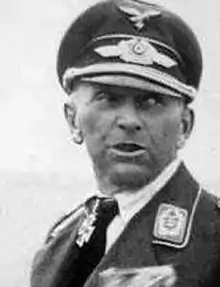Bruno Bräuer
Bruno Bräuer (4 February 1893 – 20 May 1947) was a general in the paratroop forces of Nazi Germany during World War II. He served as a commander on Crete (called Fortress Crete by the Germans) and then commanded the 9th Paratroop Division. After the war, he was convicted of war crimes and executed, along with Friedrich-Wilhelm Müller, on the anniversary of the Axis invasion of Crete.
Bruno Bräuer | |
|---|---|
 | |
| Born | 4 February 1893 Willmannsdorf, Silesia, Kingdom of Prussia, German Empire now Stanisławów, Lower Silesian Voivodeship, Poland |
| Died | 20 May 1947 (aged 54) Athens, Greece |
| Cause of death | Execution by firing squad |
| Allegiance | |
| Service/ | Luftwaffe |
| Rank | General der Fallschirmtruppe |
| Commands held | "Fortress Crete" |
| Battles/wars | World War I World War II |
| Awards | Knight's Cross of the Iron Cross |
World War II
In November 1942 Bräuer replaced General Alexander Andrae as commander on Crete. On 25 March 1943, Greek Independence Day, he released 100 Cretans jailed in Agia prison. Among them was Constantinos Mitsotakis, who later became MP and Prime Minister of Greece. After German failures at Stalingrad and El Alamein, Bräuer ordered the construction of underground command bunkers, more defenses around Suda Bay and increased ammunition stocks. He was replaced by General Friedrich-Wilhelm Müller 31 May 1944.
In January 1945, the German 9th Parachute Division was formed under Bräuer, mostly made up of Luftwaffe ground forces. In January 1945 two of his battalions were encircled by the 1st Ukrainian Front in Breslau, where they were destroyed. The rest of the division retreated back to the Seelow Heights. Many of the troops fled when the Soviet barrage began. Before long, the line had nearly completely collapsed and many of Bräuer's men began to desert. He suffered a nervous collapse and was relieved of his command.
Conviction and execution
After his capture by the British he was extradited to Greece for the deportation of the Cretan Jewish Greeks in May 1944 and put on trial there.[1] (At the end of May 1944, the Jewish citizens of Crete were arrested and shipped on the Danae to continental Europe. On June 8, the ship was sunk by HMS Vivid.)[2] Along with General Friedrich-Wilhelm Müller, Bräuer was charged with war crimes by a Greek military court. He stood trial in Athens for atrocities on Crete. Under the prosecution of Admiral Nicholas Zacharias, the Greek naval prosecutor, Bräuer was accused of the deaths of 3,000 Cretans, massacres, systematic terrorism, deportation, pillage, wanton destruction, torture and ill treatment.[3] Bräuer was convicted and sentenced to death on 9 December 1946. He was executed by firing squad at 5 o'clock on 20 May 1947, the anniversary of the Axis invasion of Crete. Historian Antony Beevor called him "a truly unfortunate man", having been executed for crimes "committed under another general".[4]
Awards
- Iron Cross (1914) 2nd Class (15 October 1914) & 1st Class (1 April 1917)[5]
- Clasp to the Iron Cross (1939) 2nd Class (20 October 1939) & 1st Class (23 May 1940)[5]
- Knight's Cross of the Iron Cross on 24 May 1940 as commander of Fallschjäger-Regiment 1[6]
- German Cross in Gold on 31 March 1942 as commander of Fallschjäger-Regiment 1[7]
References
Citations
- [Die Erde über den Gräbern bewegt sich noch Die Zeit, 20 November 1987]
- Tullia Santin: Der Holocaust in den Zeugnissen griechischer Jüdinnen und Juden (= Zeitgeschichtliche Forschungen. Band 20). Duncker & Humblot 2003, ISBN 3-428-10722-5. Berlin, Freie Univ., Diss., 2001 Santin, p. 26.
- "Some Noteworthy War Criminals" Archived April 1, 2012, at the Wayback Machine (archived here), Source: History of the United Nations War Crimes Commission and the Development of the Laws of War, United Nations War Crimes Commission. London: HMSO, 1948, p. 526, updated 29 Jan 2007 by Stuart Stein (University of the West of England), accessed 22 January 2010
- Beevor, Berlin, the downfall 1945, p. 236
- Thomas & Wegmann 1986, p. 33.
- Scherzer 2007, p. 238.
- Patzwall & Scherzer 2001, p. 57.
Bibliography
- Beevor, Antony (1991). Crete, the battle and the resistance
- Beevor, Antony (2002). Berlin, the downfall 1945, Penguin Books, ISBN 0-670-88695-5
- Patzwall, Klaus D.; Scherzer, Veit (2001). Das Deutsche Kreuz 1941 – 1945 Geschichte und Inhaber Band II [The German Cross 1941 – 1945 History and Recipients Volume 2] (in German). Norderstedt, Germany: Verlag Klaus D. Patzwall. ISBN 978-3-931533-45-8.
- Scherzer, Veit (2007). Die Ritterkreuzträger 1939–1945 Die Inhaber des Ritterkreuzes des Eisernen Kreuzes 1939 von Heer, Luftwaffe, Kriegsmarine, Waffen-SS, Volkssturm sowie mit Deutschland verbündeter Streitkräfte nach den Unterlagen des Bundesarchives [The Knight's Cross Bearers 1939–1945 The Holders of the Knight's Cross of the Iron Cross 1939 by Army, Air Force, Navy, Waffen-SS, Volkssturm and Allied Forces with Germany According to the Documents of the Federal Archives] (in German). Jena, Germany: Scherzers Militaer-Verlag. ISBN 978-3-938845-17-2.
- Thomas, Franz; Wegmann, Günter (1986). Die Ritterkreuzträger der Deutschen Wehrmacht 1939–1945 Teil II: Fallschirmjäger [The Knight's Cross Bearers of the German Wehrmacht 1939–1945 Part II: Paratroopers] (in German). Osnabrück, Germany: Biblio-Verlag. ISBN 978-3-7648-1461-8.